The Day of the Dead – the real celebration of life!
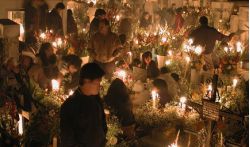
The Mexican is intimately familiar with death, jokes about it, caresses it, sleeps with it, and celebrates it.
Octavio Paz (1914–1998), a Mexican poet.
Death is a strange thing. Each of us knows that someday he will get into a dark realm of severe Hades, and at the very moment when will want to live triple. The Mexicans know it too. However, they treat it are philosophically and, rather than to mourn the dead, prefer to remember them, arranging festive processions and carnivals.
The Day of the Dead is a striking holiday, amazingly colorful and celebrated on a grand scale. It is originating from pre-Columbian times. In Mexico, the holiday festivities, songs and dances are continued for two days: the 1st of November the deceased children and infants are honored, and the 2nd of November is the day entirely dedicated to adults. The celebration coincides with two Catholic holidays – All Saints Day (November 1) and All Souls' Day (November 2).
Across the country, on the cemeteries and parish areas the special altars (ofrendas) with photos of the dead are established, decorated with bright orange flowers, similar to marigold or crocuses. The candles are lighted up. The relatives of the dead bring to altar a variety of food that once was liked by the deceased: sweets – for the kids, tequila and local cuisine – for adults. The sugar or chocolate figures – skulls (calaveras) of different sizes with the name of the deceased on the forehead and "the bread of the dead" prepared by a special recipe are traditional too.
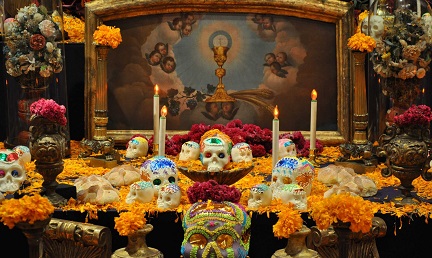
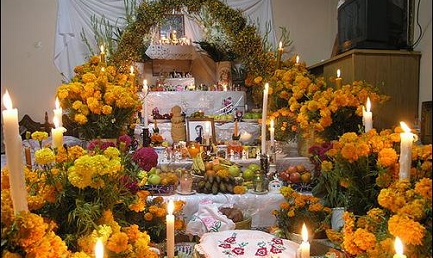
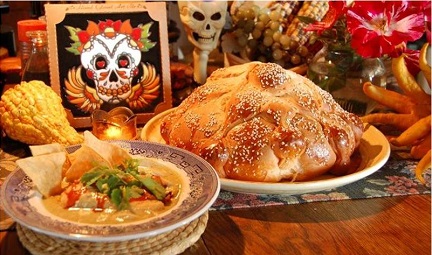
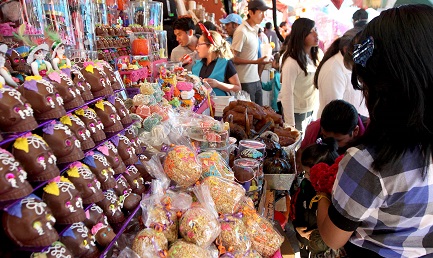
The string of people march to cemeteries to honor the memory of loved ones deceased and invite them to spend the day together. To the dead do not get lost and do not inadvertently enter at a neighbor's house, the Mexicans line the way with flowers, decorate the houses with garlands with the image of skeletons. The famous "Katrina" – the skeleton figure dressed in women's clothes – is present too. Thanks to engraving of Jose Guadalupe Posada it became a symbol of the Day of the Dead in Mexico.
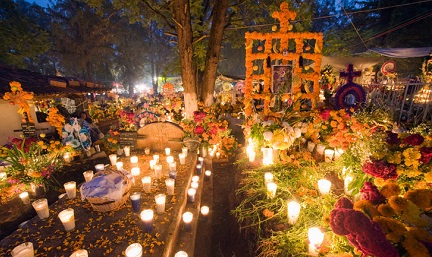
The Day of the Dead is celebrated with the whole breadth of the Mexican soul, and in every state a special celebration is arranged: somewhere the theater, dance and music performances, workshops, tours, and exhibitions are organized, and in other places it is easy to meet maskers, dancing right on the streets of towns and cities for the delight of tourists.
The state of Oaxaca, for example, is famous for its rich tradition of celebrating and bright festivities on the Day of the Dead. Everywhere the live music is, the festive processions are organized, the huge figures of sand are constructed. The idea of a reunion with deceased relatives directly at the cemetery in a festive atmosphere, the colorful decorations, the skulls and skeletons attract tourists to this crazy carnival of the death for many years.
Lake Patzcuaro in the state of Michoacan is ideal to celebrate Day of the Dead for the lovers of peace and quiet. It is far from bright, colorful festivals, but here, in nature, forgetting the daily bustle, you can enjoy the mystical atmosphere and the beauty of this holiday.
The Day of the Dead is one of the most favorite holidays of Mexicans: they are waiting and carefully preparing for it. And if you want to participate in this celebration of life, to familiarize with the Mexican culture, a look into the deep Mexican soul, to participate in the festivities and celebrations – then welcome to Mexico! The end of October and the beginning of November are quite appropriate time for this.
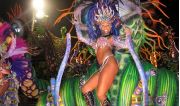
Carnival in Santiago de Cuba, because of its color, intensity, indescribable warmth and even some craziness, is one of the most popular not only among Cubans, but also in the world. Music and dances involve tourists and residents of the beautiful eastern capital of Cuba, whose body and soul are given to the carnival on the days of long-awaited holiday.
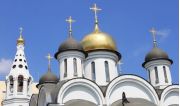
Every day, the first rays of the sun rising above the Old Havana, lit up the golden domes of the Orthodox temple – the first in Cuba and the Caribbean, which was erected in honor of Our Lady of Kazan. The church, built on the shore of Havana Bay, looks very harmonious on background of the historical part of the capital architecture.















